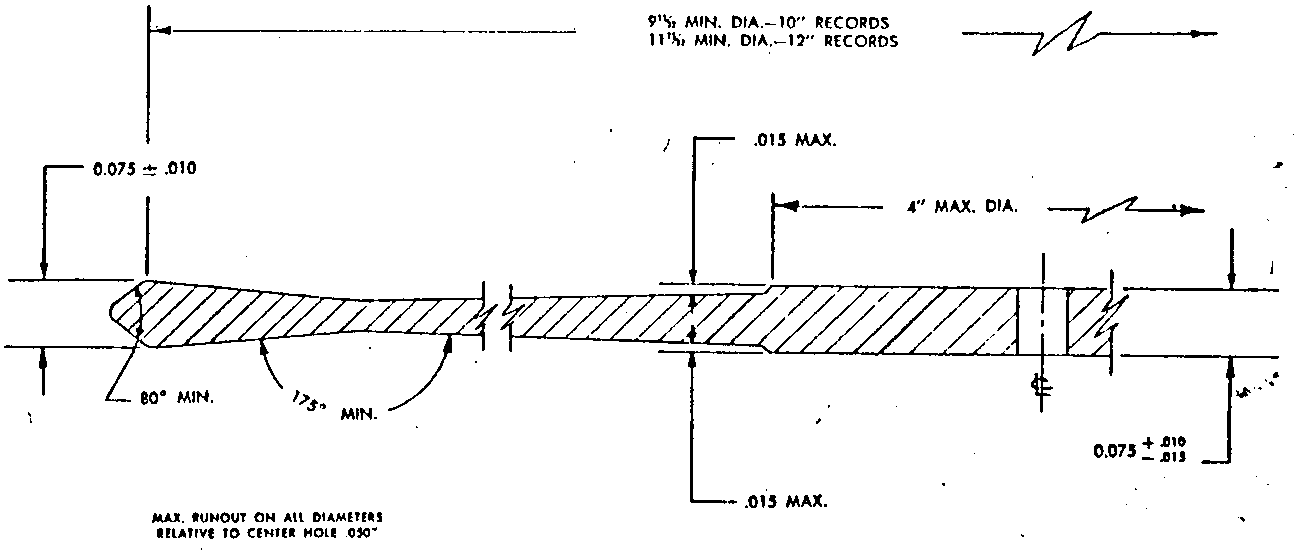Perhaps one reason it doesn’t sound as natural.
Nonsense. This thread is embarrassing. If you are playing 180 gm LPs with the same cartridge parameters you use for 120gm LPs, you are ignoring the simple physics that mandate a change in the SRA required when playing thicker vinyl if you want to obtain the best sonic results. It gets worse as arm height adjustments (for VTA/SRA) are just the beginning of the mandatory adjustments . When you change the arm height you typically have to change VTF as well (typically 0.05-0.1 gm). If you use a pivoted arm, other set-up parameters will not only be inaccurate as well (i.e azimuth, zenith?), but may cause JR Bosclair to have a stroke if you do not account for their changed requirements.
This is a topic that has been covered previously in great detail. To begin, the RIAA standard for 33 1/3 rpm LPs are listed here
What is well known is that unfortunately there is no "standard" thickness for an LP of a given weight. In general, the range of avg thickness for 120gm LPs is 1.2-1.9 mm and for 180 gm LPs it is 1.5-2.8mm. Some of this depends where you measure as the thickness is not necessarily uniform across the surface of an LP a shown here:

However, the point of several posts on this topic suggest that some folks believe that the parameters used for playback should be the same for LPs of different thickness. Or, put more accurately, that there is no difference sonically when different thickness LPs are played on the same rig. I strongly disagree. Here are some comments that I think are still relevant from previous post in 2023.
https://www.whatsbestforum.com/threads/using-wally-tools.37229/page-7#post-912061. #123
The bottom line is that 180 gm LP are generally about 0.012" (~300 microns) thicker than 120-140 gm LPs. If you have set up your LP rig with a "standard" thickness LP (generally 120gm or 140 gm LPs) and are playing180gm LPs with the same arm height, it is almost certainly not performing optimally if you do not change some important parameters; most notably arm height as mentioned above. The difference in cartridge/arm optimization between 180gm LPs and thinner LPs is so easily demonstrated that every single visitor who has heard me demonstrate this in a controlled and blinded experiment has unequivocally agreed. It's really quite easily heard. The take away summary is that for this and many more reasons, LP playback is a huge pain in the ass that is made even more onerous if you want to play LPs of different thicknesses on a rig that you optimized for playing LPs of only one thicknesses. Deal with it. Here are 4 ways to do so.
1) Adjust your arm height (and other requisite changed parameters) for optimal playback for each thickness of LP in your collection. Get a discounted rate to a psychiatric facility at the same time. You will need it.
2) Take an "ignorance is bliss" approach and don't change anything once you've optimized your system using a reference LP or LPs to set up your rig. Let's face it, the sonic changes of minute adjustments mandated by adjustments for different LP thicknesses are not earth shattering and may not be critical for many or even most listeners. In this case, an "if it ain't broke, don't fix it" mantra might just be right for you.
3) Set up your turntable for a 120 gm LP and use a 500uM thick Herbie's mat for 180 gm LPs. (Not ideal but can be very beneficial)
4) If you have a TT that allows 2 or more arms, use 2 identical arm/cartridges with one set up for 120/140gm LPs and the other for 180/200 gm LPs. This method has a lot of merit and frankly, I'm surprised its not utilized more frequently, especially by folks who consider themselves "critical" listeners.

 www.whathifi.com
www.whathifi.com







